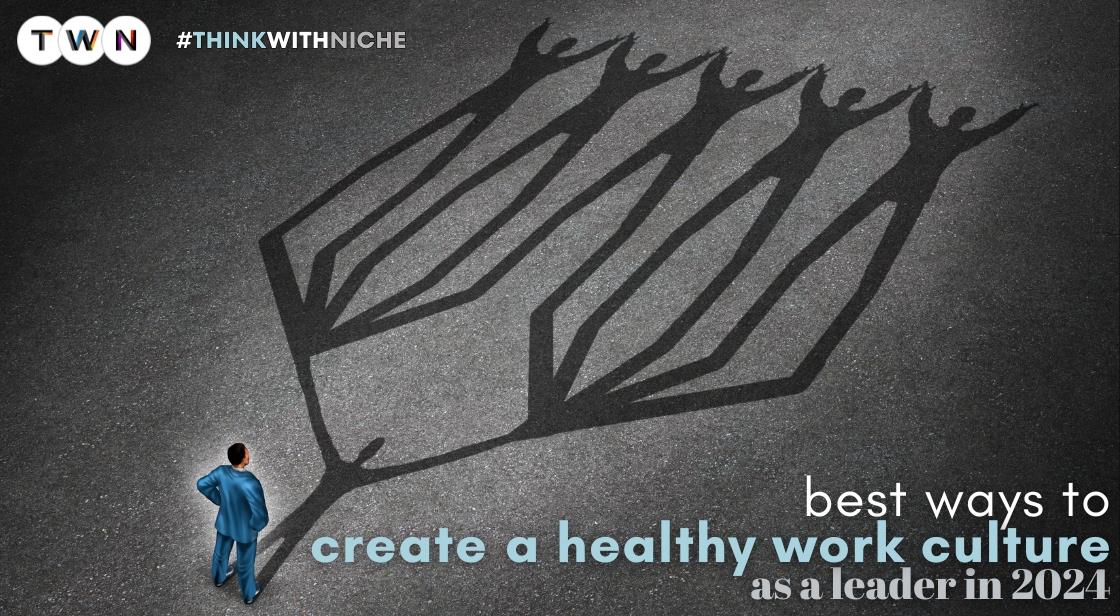Best Creative Ways to Create a Healthy Work Culture as a Leader in 2024

Blog Post
In 2024, the landscape of work culture is undergoing a transformative shift, marked by an increasing emphasis on holistic well-being, inclusivity, and adaptability. As leaders navigate the complexities of the modern workplace, they are compelled to explore innovative strategies to cultivate a healthy and thriving environment for their teams.
With the global pandemic reshaping traditional work norms and priorities, organizations are recognizing the importance of prioritizing employee health and wellness like never before.
According to recent studies, companies that prioritize employee well-being experience higher levels of productivity, engagement, and retention, underscoring the strategic imperative of fostering a healthy work culture.
Against this backdrop, leaders are embracing a multifaceted approach to crafting a healthy work culture in 2024. Central to this approach is the recognition of the diverse needs and aspirations of employees, driving initiatives aimed at embracing flexibility and inclusivity.
The evolution of the traditional 9-to-5 workday is evident, with remote work, flexible schedules, and job sharing emerging as integral components of the modern work paradigm.
Moreover, fostering inclusivity is paramount, as organizations strive to create environments where all individuals feel valued, respected, and empowered to bring their authentic selves to work.
Additionally, leaders are prioritizing employee health and well-being by leading by example, providing comprehensive wellness programs, and promoting a culture of open communication and feedback. By fostering trust and accountability, organizations lay the foundation for collaboration, innovation, and sustained success.
Encouraging continuous learning and adaptability ensures that teams remain resilient and agile in the face of change, while recognizing and celebrating achievements reinforces a sense of belonging and motivation.
As we navigate the complexities of the modern workplace, it is imperative for leaders to prioritize the health and well-being of their teams.
By embracing innovative strategies and fostering a culture of support, organizations can create environments where employees thrive, driving not only individual success but also organizational excellence in the years to come.
Innovative Strategies: Crafting a Healthy Work Culture in 2024
1. Embracing flexibility and inclusivity
Embracing flexibility and inclusivity is essential for creating a workplace that thrives on diversity and equality. Let’s explore how these concepts intersect:
1. Workplace Flexibility: The traditional 9-to-5 workday is evolving, thanks to technology and changing workforce expectations. Workplace flexibility takes various forms, including.
Remote Work: To allow employees to work from home or other locations.
Flexible Schedules: Adapting work hours to individual needs.
Job Sharing: Splitting responsibilities between multiple employees.
Compressed work week: Condensing work hours into shorter days.
These flexible models empower individuals to shape their work lives according to personal circumstances. For instance, parents juggling childcare, students pursuing education alongside careers, or those managing chronic illnesses benefit from such arrangements. Innovative companies lead the way by embracing flexibility, resulting in increased employee satisfaction, retention, and access to a wider talent pool.
2. Inclusivity: Inclusive workplaces challenge gender stereotypes and promote equal opportunities. By integrating work and personal life, reducing stigma, and addressing bias, inclusivity fosters a sense of belonging. It dismantles rigid roles and allows diverse perspectives to thrive. Inclusive leaders prioritize authenticity, emotional resilience, and self-assurance, creating a dynamic and transformative work culture.
Together, flexibility and inclusivity lay the groundwork for an innovative, diverse, and equitable future of work.
2. Prioritize Employee Health and Well-Being
1. Lead by example.
Company leaders must provide a good example for others to follow. I've found that if you put your health and well-being first, your staff may be more inclined to do the same. Furthermore, when you genuinely put your workers' health and well-being first, they will feel appreciated and inspired to put their health and well-being first as well.
2. Provide programs and benefits to support overall well-being.
Employers frequently provide physical activity and smoking cessation programs as part of their health initiatives. Wellness initiatives, however, can also cover topics like mindfulness training, stress management classes, and dietary instruction. Providing programs that cater to the interests and requirements of your staff is crucial.
3. Be flexible.
Another essential element of a positive company culture is flexible work schedules. Employees may manage their time more effectively and experience less stress when they have access to flexible work arrangements like remote work or flexible hours. I've found that many workers who have greater flexibility in their work schedules report feeling happier with their jobs and are less likely to face stress at work.
3. Fostering open communication and feedback loops
Fostering open communication within an organization is crucial for overcoming barriers and promoting growth. When leaders prioritize transparency, trust, and collaboration, they create an environment where effective decision-making and problem-solving thrive. Here are various methods to make this happen:
1. Leading by example: As a leader, demonstrate open communication by actively listening to employees, encouraging dialogue, and sharing information transparently.
2. Create Safe Spaces: Establish an environment where team members feel comfortable expressing their thoughts and ideas without fear of judgment or reprisal. Encourage open discussion and value diverse points of view.
3. Provide Communication Training: Equip employees with effective communication skills. Training sessions can focus on active listening, conflict resolution, and constructive feedback.
4. Foster Feedback and Constructive Criticism: Regularly seek feedback from team members. Constructive criticism helps identify areas for improvement and encourages continuous learning.
5. Establish Regular Communication Channels: Set up channels for open dialogue, such as team meetings, suggestion boxes, or digital platforms. These channels allow employees to share their opinions and ideas openly.
Remember, open communication not only enhances organizational dynamics but also contributes to personal and professional growth. By breaking down communication barriers, we create a culture where everyone’s voice is heard and valued.
Also Read: Finding and Maintaining a Healthy Work/Personal Life Balance
4. Cultivating a culture of trust and Accountability
Cultivating a culture of trust and accountability within an organization is crucial for its success. Let’s explore what this entails and how leaders can foster such a culture:
1. Define Workplace Expectations: Articulate expectations for employees. This involves setting standards and goals that everyone is responsible for meeting. When employees know what’s expected of them, they can align their efforts accordingly.
2. Set Strong Goals: Ambitious goals motivate accountability. When employees understand the desired outcomes and the steps to achieve them, they become more engaged with their work. These goals serve as guideposts for accountability.
3. Monitor Progress: Regularly track progress toward goals. This helps identify any deviations early on and allows for timely adjustments. Monitoring progress ensures that everyone stays on track and accountable.
4. Encourage Commitment: Foster a sense of commitment among team members. When individuals feel invested in their work and the team’s success, they are more likely to take ownership and be accountable.
5. Communicate Consequences: Make sure employees understand the impact of their actions. Clear communication about both positive and negative consequences reinforces accountability. It’s essential to emphasize that accountability is not about punishment but about shared responsibility.
6. Show Leadership: Leaders play a vital role in shaping culture. Lead by example - demonstrate accountability, admit mistakes, and take responsibility. When leaders hold accountability in place, it sets the tone for the entire organization.
7. Take Responsibility for Mistakes: Encourage a culture where mistakes are seen as opportunities to learn. When employees feel safe admitting errors, they are more likely to learn from them and improve. Accountability includes owning up to both successes and failures.
8. Gather Feedback from Employees: Actively seek input from team members. Their perspectives can highlight blind spots and provide insights into areas where accountability can be strengthened. Regular feedback encourages a culture of continuous improvement.
Remember, a culture of accountability isn’t about rigid control or blame—it’s about empowering individuals to take ownership, collaborate, and contribute to the organization’s success. When trust and accountability thrive, productivity, morale, and innovation follow suit.
5. Encouraging continuous learning and Adaptability
Continuous learning and adaptability are essential qualities that empower individuals to thrive in an ever-evolving world. Let’s explore how these attributes contribute to personal and professional growth:
1. Continuous Learning:
Curiosity: Cultivate a curious mindset. Ask questions, seek knowledge, and explore new subjects. Curiosity fuels learning.
Lifelong Learning: Recognize that learning doesn’t end with formal education. Read books, take online courses, attend workshops, and engage in self-study.
Stay Updated: Keep pace with industry trends, technological advancements, and global developments. Regularly update your skills.
Learn from Failures: Embrace failures as learning opportunities. Analyze what went wrong and optimize accordingly.
2. Adaptability:
Flexibility: Be open to change. Adaptability involves adjusting to new circumstances, whether it’s a new job, technology, or environment.
Resilience: Bounce back from setbacks. Resilient individuals view challenges as stepping stones rather than obstacles.
Embrace Uncertainty: The world is unpredictable. Develop the ability to thrive in ambiguity.
Cultural Intelligence: Understand and appreciate diverse perspectives. Adapt to different cultural norms and practices.
Remember, growth happens outside your comfort zone. So, keep learning, stay adaptable, and embrace the journey of self-improvement.
6. Recognizing and celebrating achievements
Recognizing and celebrating achievements is vital in both personal and professional contexts. It fuels motivation, boosts morale, and fosters a positive work culture. Here are some effective ways to acknowledge accomplishments:
1. Celebrating Milestones and Goals:
Take the time to recognize important milestones and goals achieved by individuals and teams. Whether it’s completing a challenging project, reaching a significant target, or meeting key performance indicators, acknowledge these accomplishments. Share them with the team, emphasizing the hard work, dedication, and impact they’ve made.
2. Publicly Recognizing Outstanding Contributions:
Highlight exceptional performances by individuals or teams. Whether through team announcements, virtual award ceremonies, or shout-outs during meetings, public recognition reinforces positive outcomes and inspires others to excel.
3. Creating a Culture of Appreciation:
Incorporate appreciation and recognition as a fundamental aspect of team culture. Encourage team members to express gratitude and recognize each other’s efforts. Establish platforms where they can share appreciative messages, thank-you notes, or virtual applause. A culture of appreciation fosters a positive work environment where individuals feel valued and motivated.
4. Providing Timely and Specific Feedback:
Offer feedback that not only focuses on areas of improvement but also highlights successes and achievements. Recognize effort and skill demonstrated in achieving or meeting goals with exceptional results. Constructive feedback encourages continued growth and a culture of continuous improvement.
5. Tailoring Recognition to Individual Preferences:
Understand that individuals have unique preferences when it comes to receiving recognition. Some may appreciate public acknowledgment, while others prefer a more private approach. Tailor your recognition efforts to suit individual preferences and personalities.
6. Encouraging Peer-to-Peer Recognition:
Encourage team members to recognize and celebrate each other's achievements. Peer-to-peer recognition strengthens team bonds and reinforces a sense of camaraderie.
7. Incentives and Rewards:
Consider offering incentives or rewards for outstanding achievements. These can range from bonuses and promotions to extra vacation days or personalized gifts. Tangible rewards show appreciation and motivate individuals to strive for excellence.
8. Sharing Success Stories:
Share success stories within the organization. Highlight how individuals or teams overcame challenges, achieved goals, and made a positive impact. Success stories inspire others and create a sense of pride and unity.
7. Promoting work-life integration
Work-life integration is a concept that acknowledges the blurred boundaries between work and personal life. Unlike the traditional notion of work-life balance, where there’s a clear line between the two, work-life integration encourages finding ways to seamlessly blend work and personal activities. Here are some strategies to promote work-life integration among employees:
Shift Perspective: Help employees understand that work-life integration is not an optional approach but rather the default in today’s culture. When hiring, clearly communicate the expectations around work-life integration as part of the job. By framing it as a natural aspect of their role, employees can adapt more positively.
Healthy Engagement: Provide training on how to stay engaged healthily. While it’s tempting to be constantly connected (checking emails during family events, for instance), encourage mindful attention. Balancing work and personal life doesn’t mean constant multitasking; it’s about being present when needed.
Creative Scheduling: Be creative with shifts and hours. Allow flexibility for personal errands during work hours or vice versa. For example, employees can hit the gym during lunch breaks or attend work meetings in the evening.
Benefits Communication: Emphasize the benefits of work-life integration. Increased productivity, higher job satisfaction, and improved mental Healthcare are some advantages. When employees see the positive impact, they’re more likely to embrace this approach.
Collective Commitment: Ensure everyone is on board. When work and personal life blend, it’s essential that both employees and employers actively support this integration. Foster a culture where everyone recognizes its value.
8. Establish Confidence
You must first trust your colleagues and staff if you want them to trust you in return. even when they don't feel fully confident in themselves, to have faith in their capacity to succeed. People will be inspired to grow and expand when high standards and expectations are held.
How to improve a healthy work culture?
Improving company culture is essential for fostering a positive work environment and enhancing employee satisfaction. Here are some practical ideas to enhance your company culture:
Establish Purpose:
1. Clearly define your company’s mission statement and core values.
2. Set clear expectations for team members and specify project timelines.
3. Hold regular all-hands meetings where departments share progress.
4. Knowing how individual efforts fit into the bigger picture boosts productivity and motivates employees.
Open Up Communication:
1. Be available for employees and encourage cross-functional collaboration.
2. Set up an anonymous feedback system and listen to employee input.
Create Opportunities for Connection:
1. Even in a remote work environment, facilitate ways for employees to connect.
2. Foster team bonding through virtual events, team-building activities, or social gatherings.
3. Strong connections among team members contribute to a healthier work culture.
Prioritize Transparency:
1. Share information about company decisions, goals, and performance.
2. Transparency builds trust and empowers employees to make informed choices.
3. Regularly communicate updates and changes to keep everyone informed.
Recognize and Appreciate Employees:
1. Implement an employee recognition program to celebrate achievements.
2. Acknowledge individual and team contributions publicly.
3. Feeling valued and appreciated positively impacts morale and engagement.
Conclusion
It is critical to give staff members the tools they require to put their health and well-being first. This might involve having access to services for mental wellness, physical fitness, and healthcare.
It goes beyond simply providing healthcare benefits, though. Make certain that workers can get the necessary, high-quality healthcare. In a similar vein, providing gym membership discounts or fitness centers may incentivize staff to put their physical well-being first. You can make your workplace happier, healthier, and more productive by putting your employees' physical, mental, and emotional well-being first.
You May Like
EDITOR’S CHOICE












